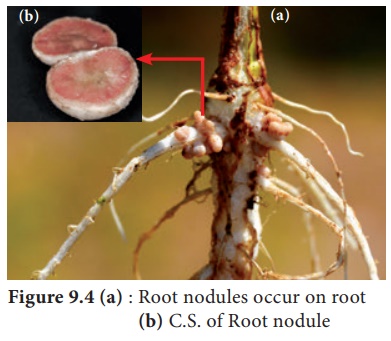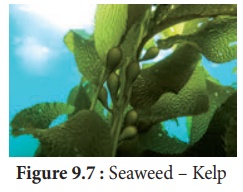Chapter: 12th Botany : Chapter 9 : Plant Breeding
Organic Agriculture
Organic Agriculture
Organic farming is an alternative agricultural system which
originated early in the twentieth century in reaction to rapidly changing
farming practices. It is a production system that sustains the health of the
soils, ecosystems and people. It relies on ecological processes, biodiversity
and cycles adapted to local conditions rather than the use of inputs with
adverse effects.
1. Biofertilizers
Biofertilizers are defined as preparations containing living cells
or latent cells of efficient strains of microorganisms that help crop plants
uptake of nutrients by their interactions in the rhizosphere when applied
through seed or soil. Biofertilizers could be also called as microbial
cultures, bioinoculants, bacterial inoculants or bacterial fertilizers.
They are efficient in fixing nitrogen, solubilising phosphate and
decomposing cellulose. They are designed to improve the soil fertility, plant
growth, and also the number and biological activity of beneficial
microorganisms in the soil. They are eco-friendly organic agro inputs and are
more efficient and cost effective than chemical fertilizers.

Rhizobium
Bio-fertilisers containing rhizobium bacteria are called rhizobium
bio-fertilizer culture. Symbiotic bacteria that reside inside the root nodules
convert the atmospheric nitrogen into a bio available form to the plants. This
nitrogen fixing bacterium when applied to the soil undergoes multiplication in
billions and fixes the atmospheric nitrogen in the soil. Rhizobium is best
suited for the paddy fields which increase the yield by 15 – 40%.

Azolla
Azolla is a free-floating water fern that fixes the atmospheric
nitrogen in association with nitrogen fixing blue green alga Anabaena azolla.
It is used as a bio-fertilizer for wetland rice cultivation and is known to
contribute 40 – 60 kg/ha/crop. The agronomic potential of Azolla is quite
significant particularly for increasing the yield of rice crop, as it quickly
decompose in soil.

Arbuscular mycorrhizae
Arbuscular mycorrhizae (AM) is formed by the symbiotic association
between certain phycomycetous fungi and angiosperm roots. They have the ability
to dissolve the phosphates found in abundance in the soil.

Apart from increasing the availability of phosphorus, AM provides
necessary strength to resist disease, germs and unfavourable weather
conditions. It also assures water availability.
Seaweed Liquid Fertilizer
Sea weed liquid fertilizer (SLF) contain scytokinin,
gibberellins and auxin apart from macro and micro nutrients. Most seaweed based
fertilizers are made from kelp(brown algae) which grows to length of 150
metres. Liquid seaweed fertilizer

The alginates in the
seaweed that reacts with metals in the linked polymers in the soil. These
polymers improve the crumbing in the soil, swell up when they get wet and
retain moisture for a long time. They are especially useful in organic
gardening which provides carbohydrates for plants. Seaweed has more than 70
minerals, vitamins and enzymes. It promotes vigorous growth. Improves
resistance of plants to frost and disease. Seeds soaked in seaweed extract
germinate much rapidly and develop a better root system.
Bio-Pesticides
Bio-pesticides are biologically based agents used for the control
of plant pests. They are in high use due to their non-toxic, cheaper and
eco-friendly characteristics as compared to chemical or synthetic pesticides.
Bio-pesticides have become an integral component of pest management in terms of
the environmental and health issues attributed to the use of chemicals in
agriculture.
Trichoderma species are free-living fungi that
are common in soil and root ecosystem. They have been recognized as bio-control
agent for (1) the control of plant disease (2) ability to enhance root growth
development (3) crop productivity (4) resistance to abiotic stress and (5)
uptake and use of nutrients.

Beauveria species is an entomo-pathogenic fungus that grows
naturally in soils throughout the world. It acts as a parasite on various
arthropod species causing white muscardine disease without affecting the plant
health and growth. It also controls damping off of tomato caused by Rhizoctonia
solani.

Green Manuring
Green manuring is defined as the growing of green manure crops and
use of these crops directly in the field by ploughing. One of the main
objectives of the green manuring is to increase the content of nitrogen in the
soil. Also it helps in improving the structure and physical properties of the
soil. The most important green manure crops are Crotalaria juncea, Tephrosia
purpurea, Indigofera tinctoria
The green manuring can be practised as Green in-situ manuring or
Green leaf manuring. Green in-situ manuring refers to the growing of green
manuring crops in the border rows or as intercrops along with the main crops.
Example: Sun hemp, Cowpea, Green gram etc. whereas green leaf manuring is the
application of green leaves and twigs of trees, shrubs, plants growing in
wastelands and field bunds. The important plant species useful for green leaf
manure are Cassia fistula, Sesbania grandiflora, Azadirachta indica,
Delonix regia, Pongamia pinnata etc.,
Related Topics